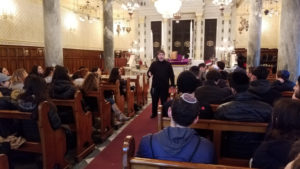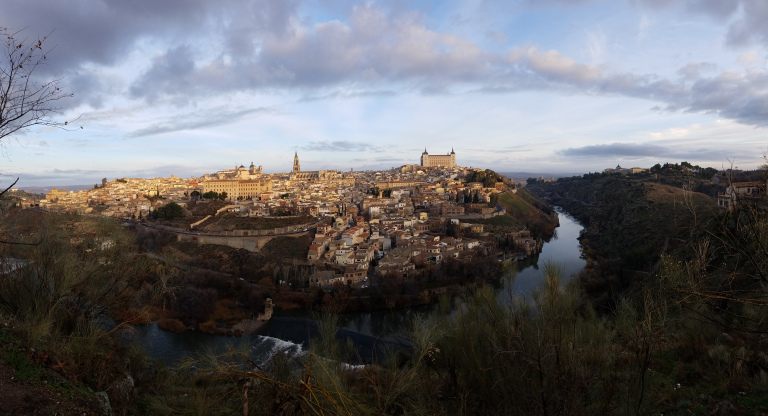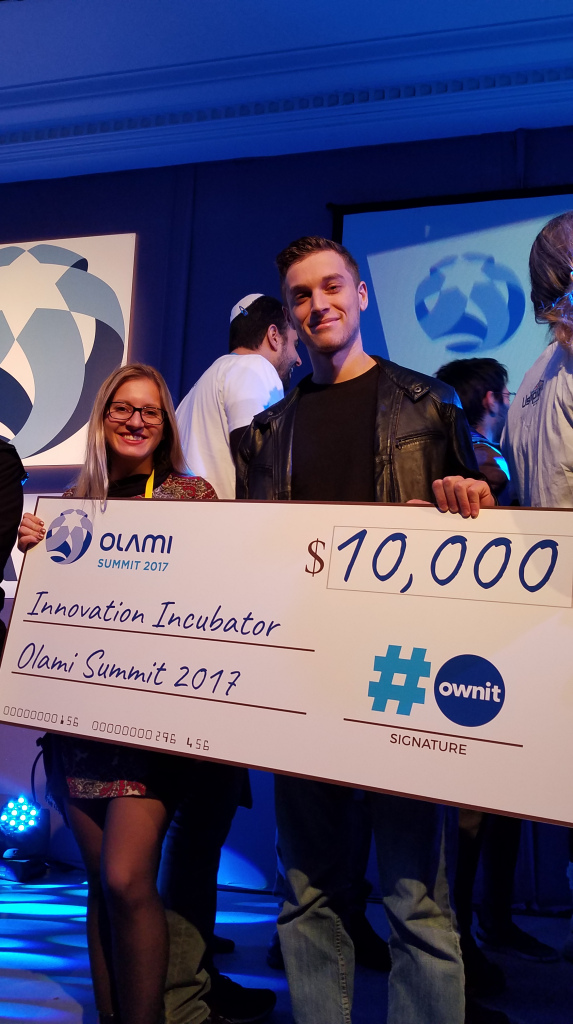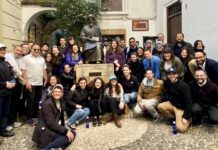On Being in Spain and England with 1,000 Jewish students
By Rabbi Zev Kahn
My wife and I recently attended the 2nd Olami International Summit along with 1,000 Jewish students and young professionals from around the world. Olami is an organization that provides support to a worldwide network of Jewish outreach organizations including JET. The Summit schedule was: Arrival in Madrid Sunday, 3 days of touring Spain and Gibraltar, a charter flight Thursday morning to London for the official opening ceremony, transfer to Birmingham for a 4 day learning, inspiring and fun experience that included Shabbat. Here are some of my initial thoughts on the experience.
We landed in Madrid and were greeted at the airport by Olami staff. A contingent of 650 students would arrive over the next 24 hours and we traveled in 12 buses. It was my first time to Spain. In preparation, I’d read about the glorious history of the Jews in Spain and their expulsion in 1492.
Our first stop was Avila, northwest of Madrid. Gigantic medieval walls surround the old city, which was home to a Jewish community before the expulsion. We paused to look at some gravestones which had recently been found and determined to be Jewish. A symbolic plaque reading ‘Sefarad’ (Spain in Hebrew) lay on the ground. We would see these throughout our visit. We took a walking tour inside the walls of the city. There was nothing Jewish to see, only churches that were once synagogues and houses that once belonged to Jews. The tour guide was not Jewish. There are no Jews in Avila. There haven’t been for 526 years. It was December 24. People were celebrating their holiday. It felt like a ghost town.
At a gas station break on our way to Segovia, we said mincha (the afternoon prayer). It struck me that back then Jews must have traveled in this area, and might too have stopped to say mincha here. This might be the first time in 526 years that mincha was said in this spot.
Particularly scenic was the city of Toledo, strategically placed on a hill with a wide river almost surrounding it. We visited a Jewish museum that used to be a synagogue, and passed another synagogue which is now a church. Apparently, the design of the old city was typical for the time, and closely resembles the Old City of Jerusalem. Except all that is left here is memories.
Looks like Israel
Driving through the scenic hilly countryside of southern Spain is like driving in the Galil in Israel. Only when you are driving in Israel there is something to say at every turn of the road – a reference to place in the Torah, a gravesite of a great Rabbi, a memorable battle fought in modern times. However, all through the drive, there was nothing to say. Jewishly, of course. There’s lots to say about the history and culture of Spain.
There have obviously been many Jewish tours of Spain. Spain was the center of the Jewish world for hundreds of years. However, we were with 650 Jewish students who were here to celebrate their Jewish identity, take ownership of their Jewish future and discover new ways to engage their fellow Jewish friends. It was like we were saying: You tried to remove all trace of Jews from Spain. Well, we are back, stronger than ever.
One powerful moment that will remain with me was in the main city square in Madrid. Rabbi Benzi Klatzko, legendary outreach Rabbi and founder of shabbat.com, led us on a late night walking tour of Madrid, pointing out places where Jews lived, were tried and then executed. We sang ‘vhi she-amda’, the song that comes from the age-old passage in the Haggadah, that reads ”
We drove all the way to the southern tip of Spain and entered Gibraltar, a completely different and fascinating place with a fascinating history, that belongs to England and is still contested by Spain. Our very English tour guide took us around the city and up to favorite spot of tourists where we could see the famous monkeys of Gibraltar. What was more meaningful to me was visiting the vibrant Jewish community and standing in an active synagogue and hearing about a bar mitzvah that just took place and the new families who were moving in.
The Summit itself
We then headed back to Seville and early the next morning took a charter plane to England itself for the official opening ceremony of the Summit itself. Held at O2 in central London, 1,000 students from 20 countries converged. The atmosphere was electric. The sense of shared community and purpose was the central theme of the night, highlighted by an inspiring speech by the former Chief Rabbi of England, Chief Rabbi Sir Jonathan Sacks.
Then back on the buses and up to Birmingham where we were spending Shabbat. It’s hard to put into words what happened over the next three days. There were 1,500 students and staff and guests and logistics crew and caterers and security. The program was jam packed and the students soaked it all in – and then some, staying up late every night, meeting and shmoozing with each other, singing, enjoying and celebrating the moment.
Kabbalat Shabbat with spirited singing and dancing was preceded by a young man who proposed to his girlfriend only moments before Shabbat began. He had been at the first Summit last year in Sao Paulo, Brazil and was so inspired he decide to propose at this year’s Summit. There were two giant Torah learning sessions where students were split into small groups to study one chapter of the entire Chumash (5 books of the Torah) which then culminated in a dedication of a Torah scroll to Mr. Eli Horn, one of the patrons of Olami, by his good friend and fellow patron, Mr. Aaron Wolfson. During that celebration, another young man, moved by the whole experience decided to propose to his girlfriend.
The highlight for my wife and me and the JET students came towards the very end of the Summit. At the penultimate session, in front of 1,500 people, the regional winners of the Innovative Incubator competition were announced. After last year’s Summit which also had a competition for student led projects, I was inspired to find one ourselves and came up with the Positive Speech Project together with some students at U of I in Champaign. After a successful pilot program, our submission to the competition was to take this national and international. Yana Garmash, with help from Loyola student, Alec Ricker, presented magnificently to the judges of the North American region. When the winners of all the regions were announced, I waited with bated breath. Baruch Hashem, JET was selected as the winner! Yana and Alec stepped up to accept the $10,000 prize. The prize money will be used to run programs in the US and Canada this semester. I asked Yana a few days later how she felt and she said it still felt surreal.
In fact, the whole week of the Summit still feels surreal. It was a unique experience which I feel very honored to have been a part of it.
Rabbi Zev Kahn is better known in the Chicagoland area as the “Rugby Rabbi” from his days as a former Maccabi Games Gold Medalist in 1985 and 1989. Originally from Port Elizabeth, South Africa, Zev played for University of Cape Town and Western Province under 20, before being selected to represent South Africa. Zev came to Chicago after spending six years at Ohr Somayach in Jerusalem, where he completed the Ohr Lagolah teacher training program and was very involved in college student touring programs. The Kahns moved to Chicago in 1998 to work for the Chicago Community Kollel, and in 2005 Rabbi Kahn founded JET – Jewish Education Team, an outreach organization that reaches about 1,000 college students and young professionals throughout Illinois (see www.jetcampus.com). He can be reached at [email protected]












